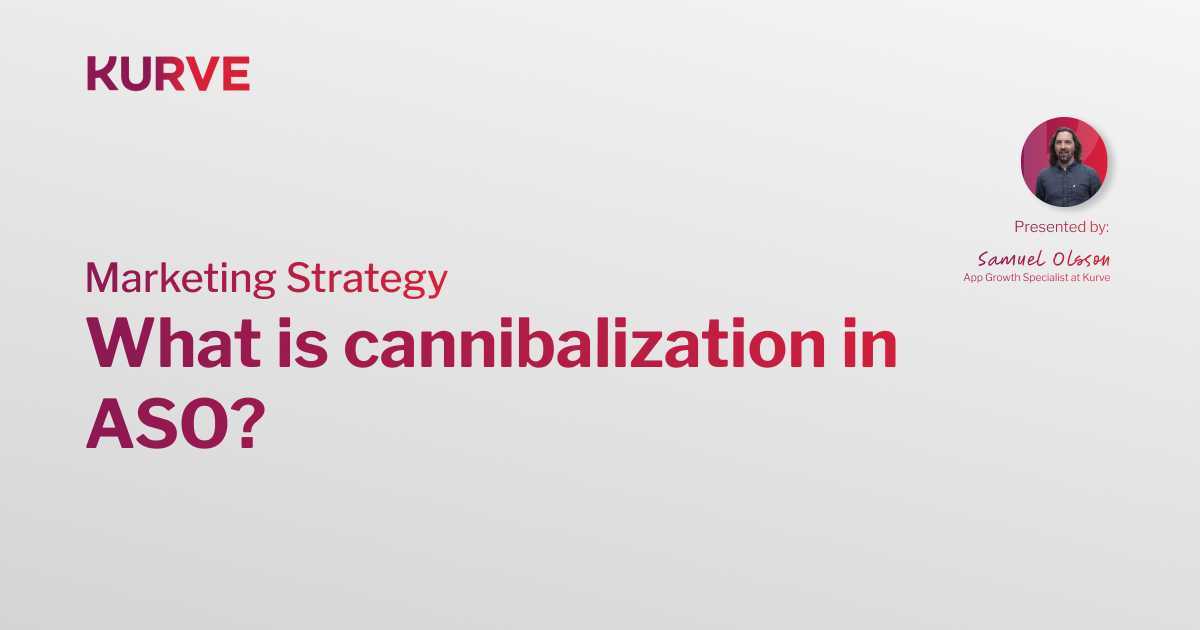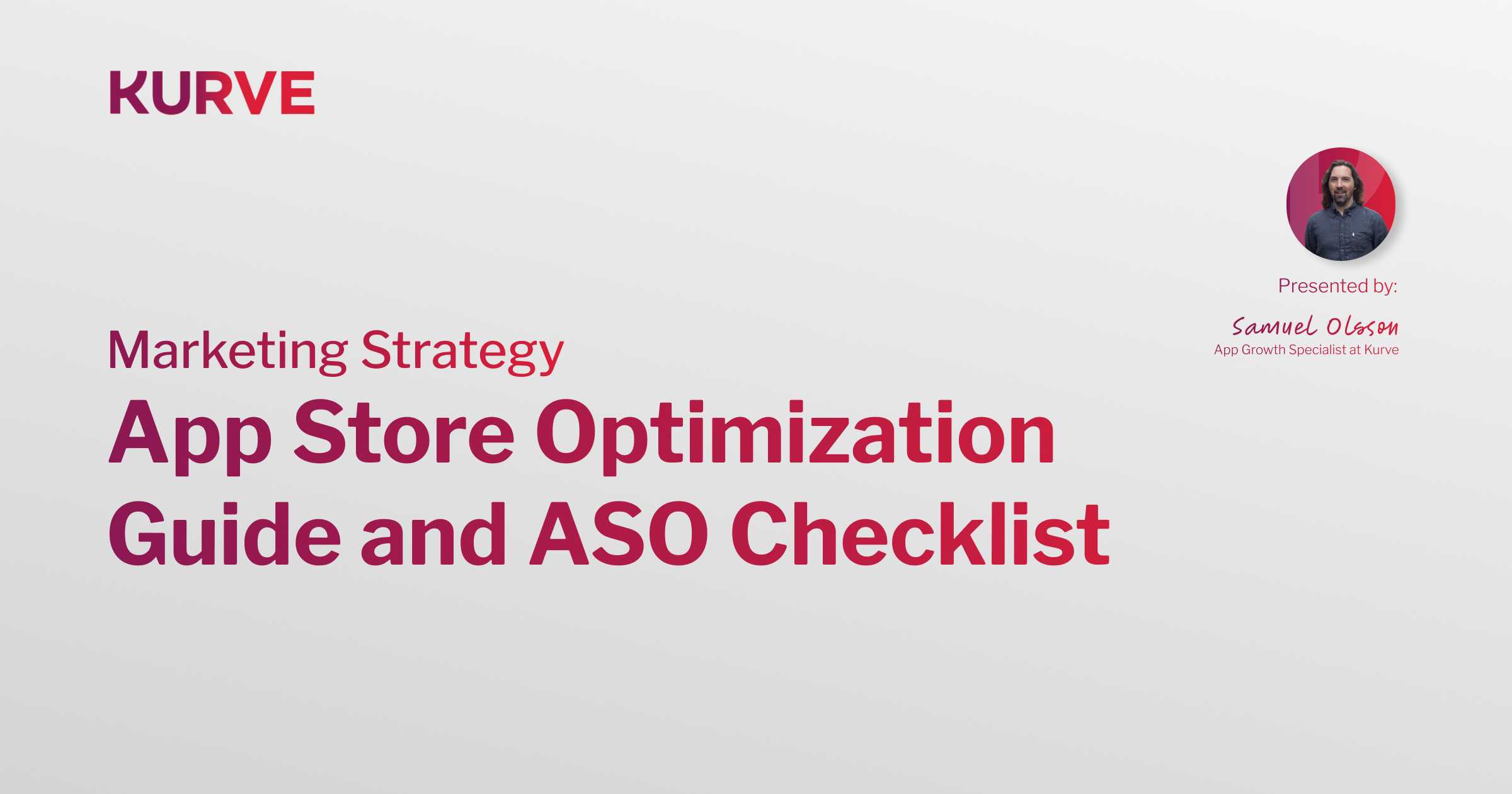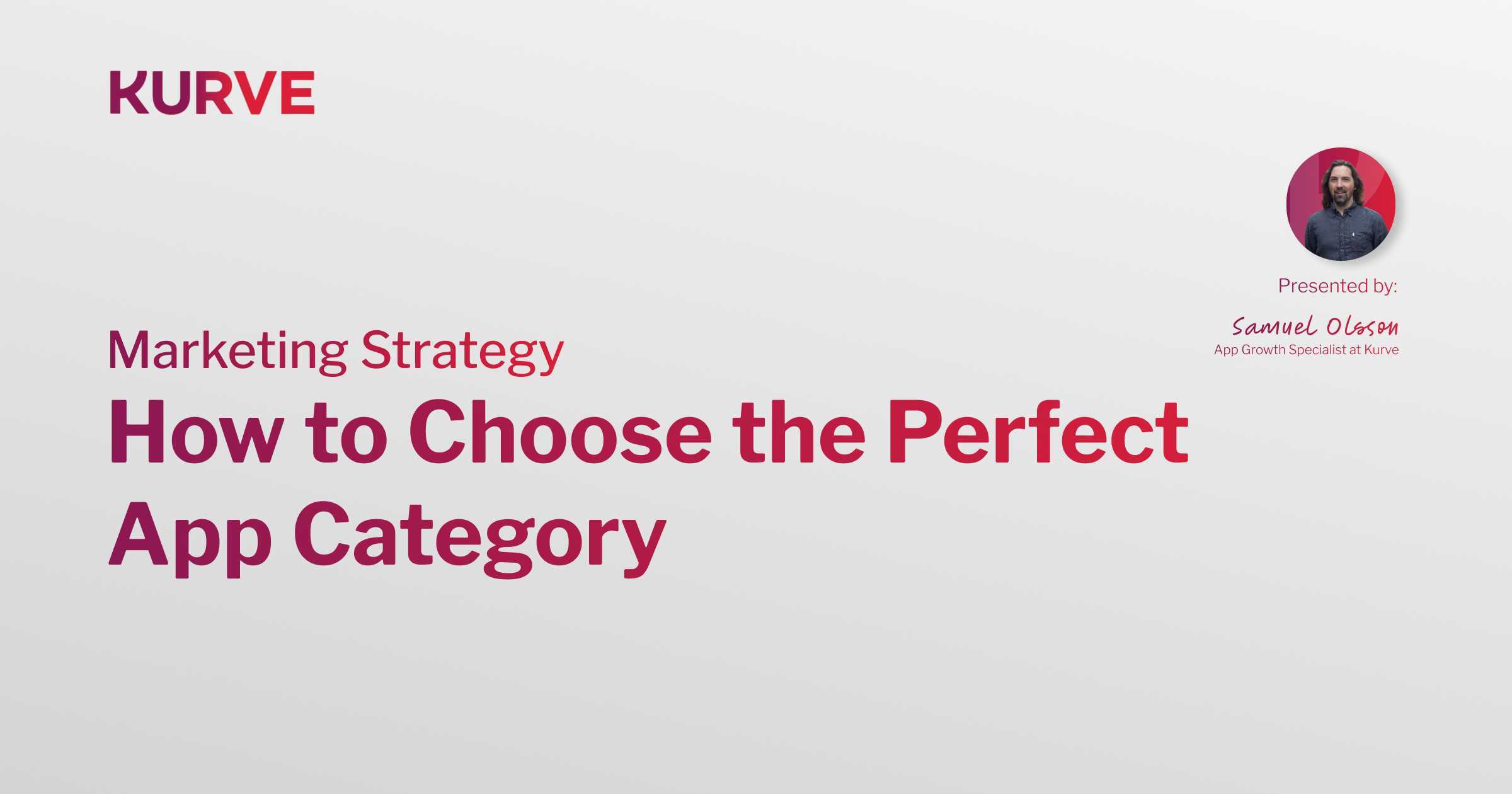Marketing Automation Implementation: 10 Key Steps
How to Implement Your Marketing Automation Strategy
This article is written by B2B Marketing Consultant, Jonno Price So, you’ve decided to proceed and implement marketing automation. Great! Before you start, let’s take a moment to consider what will give you the best possible chance of success. People often get their hands on new software and jump in head-first to set up sequences. However, whilst the temptation to get tactical quickly is compelling, the importance of planning cannot be overstated. From experience implementing complex automation, my advice is to exert 60% of your effort into planning and tech integration and 40% on producing content, customer journeys, and sequences. The groundwork consists of planning and project management processes, and infrastructure consists of marketing tools and tech setup. With the right combination of both, automated content and sequences will be far quicker and infinitely more effective . This article addresses the aforementioned 60% of effort, broken down into the following:
-
Martech stack planning
-
Project management processes and responsibilities
-
Understanding data flows and event triggers
-
Preparing the appropriate developer resource
-
Persona review, buyer journey mapping, and content audit
-
GIGO (garbage in, garbage out) and the importance of data cleansing
-
Cracking the 360 single view of the customer across tools
-
Prioritising the top 3 automation journeys
-
Team training and onboarding
-
Reporting and goals
1. Marketing Automation Technology Planning
You could write a whole book about the marketing tech stack. Some have. For good reason! But the key point here is that careful planning is paramount. The complexity and components of any one martech stack will vary greatly depending on business requirements, type (B2B or B2C), product, service (SaaS or eCommerce), resources (team and consultants), and of course... budget! Even with a simple tech stack, you need to carefully consider which tools to use and how they connect to each other before entering your credit card details into a subscription. Changing or ditching tools further down the line can be costly, time-consuming, and a general pain in the arse. The illustration below might look complex at first glance, but it’s a fairly standard setup for a small to medium-sized SaaS business.
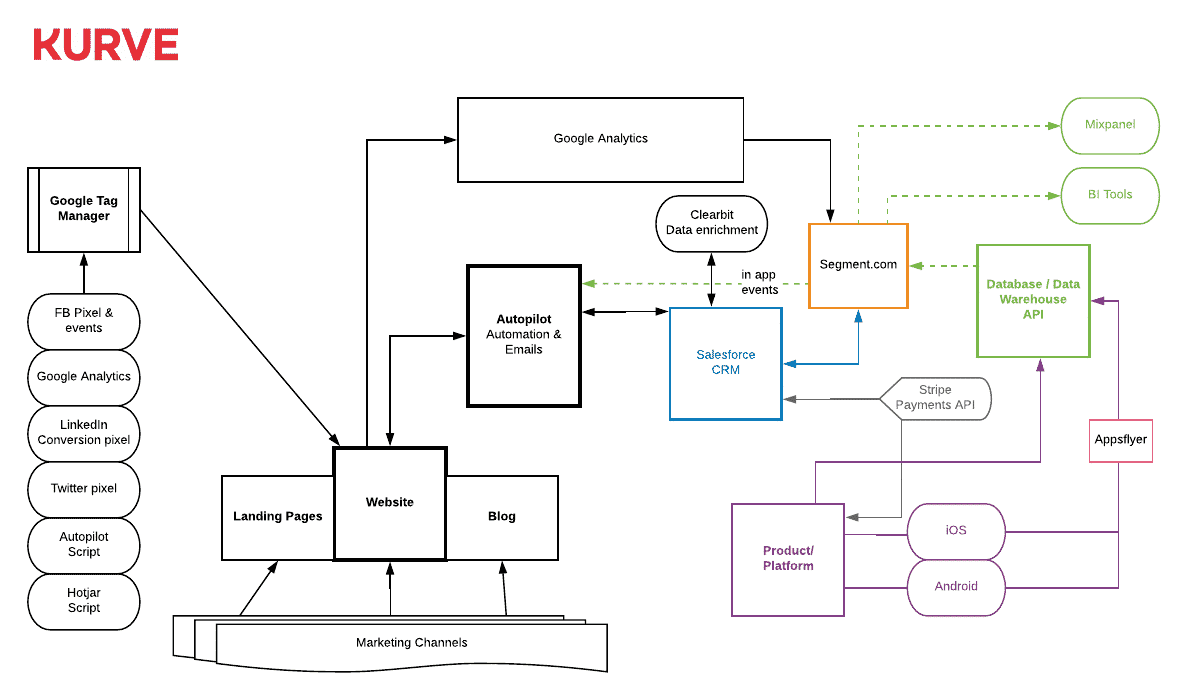 Fig 1. Martech stack - for illustrative purposes only
Fig 1. Martech stack - for illustrative purposes only
Note 1 : Fig 1. is mainly looking at tech as it relates to the website and automation software. It could be significantly more detailed, incorporating tools for social media, chat, outreach, CRO, ad tech, and more. This could be further extended with team communication and collaboration tools. Note 2: In the illustration, plus in some examples below, I’ve used Autopilot as the automation software. This is just an example, and is one of the very many solutions available. The folks at Ops.TV pulled together this incredible Google Sheet with a comparison of over 100 marketing automation software providers . One thing is for certain: The CMO and CTO must work together when planning the marketing technology stack . Fire up your diagramming tool (e.g. Lucidchart , Google Drawings, etc.) or use the old-fashioned whiteboard to create a flowchart. Even with the tightest planning, this might evolve. But for the most part, you should have tool component selection in place before venturing further.
2. Project Management Processes and Responsibilities
It’s tough – yet satisfying – to choose shiny new tools for your martech stack. At the same time, you should be working on the project management process for what will grow to be a complex beast. Ideally, you need a dedicated marketing automation implementation project manager, a.k.a. “The Automator”(!) . These black-belt project management skills will help pull together the project plan with feasible timelines and designated responsibilities. Speaking from experience, setting up an automation implementation requires constant communication with many different stakeholders. This takes time and effort, adding more to daily task management, troubleshooting, and the straightforward badgering of all involved in the process. A PM with complete ownership and backing from decision-makers will keep things on track and on budget. These are the key moving parts:
-
Tech team required for initial implementation and integration
-
Access to decision-makers to unblock inevitable obstacles (MD, CTO, CMO, etc.)
-
Content team to prepare copy and content for automation sequences
-
Design (if required) to set up email templates and more
-
Sales team to understand sales cycle and automation’s impact on sales processes
-
Customer success / support teams for automation’s impact on processes
My project management tools of choice are as follows:
-
Asana for all task management
-
Google Docs for final detail such as templates and working documents
-
Slack for team or agency communication
-
Atlassian Confluence for project overviews, wiki, and meeting / call notes
-
Lucidchart for diagramming and visualisation
3. Understand Data Flows & Event Triggers
Even seemingly simple automated sequences need a lot of data points and “triggers”. The reason why you should start to think about different kinds of data sources and triggers now is because it’ll help you make better choices in martech stack planning. It will also help to determine which automation software is the best fit for your requirements, and how much dev resource is needed (see point 4 below).  An example of planning sequences: You want to set up a lead nurture sequence of emails, built around a lead magnet such as downloadable eBook. The call-to-action (CTA) is for a free trial of your SaaS product. If the person signs up, they must be ejected from the journey (to prevent any further nurturing emails) and entered into an onboarding sequence for the free trial. Sounds simple, right? Not so. You’ll need the following: 1. A data source , for example a landing page ( Instapage , Unbounce , etc.) with a form that creates a record when completed. This needs to be integrated with your email automation software, either with an out-of-the-box integration or via a tool like Zapier . 2. A conversion event should be recorded for the eBook download in your analytics software, and the UTMs must be captured to attribute marketing campaigns correctly. 3. Once the email is added to the right list in the automation/email software, the contact enters the lead nurture journey and starts to receive drip-fed emails. 4. If the contact gets enticed by your email CTA and signs up to your free trial, an event must be triggered by your platform. This is then fed into the automation software (via direct API or a tool like Segment ) against the correct record (which may need user ID or email matching) in order for the record to be ejected from the automation journey and placed into a different list. The above is a simple example, in truth. These processes can get far more complicated, particularly if you’re using the automation software to run contextual customer onboarding journeys that rely on multiple in-app user metrics. The main point here is that you must brainstorm some of the automation journeys and consider what this means in practice from a data source and trigger perspective. These plans must be discussed with your tech and product team to understand whether the necessary event triggers will be made available or not.
An example of planning sequences: You want to set up a lead nurture sequence of emails, built around a lead magnet such as downloadable eBook. The call-to-action (CTA) is for a free trial of your SaaS product. If the person signs up, they must be ejected from the journey (to prevent any further nurturing emails) and entered into an onboarding sequence for the free trial. Sounds simple, right? Not so. You’ll need the following: 1. A data source , for example a landing page ( Instapage , Unbounce , etc.) with a form that creates a record when completed. This needs to be integrated with your email automation software, either with an out-of-the-box integration or via a tool like Zapier . 2. A conversion event should be recorded for the eBook download in your analytics software, and the UTMs must be captured to attribute marketing campaigns correctly. 3. Once the email is added to the right list in the automation/email software, the contact enters the lead nurture journey and starts to receive drip-fed emails. 4. If the contact gets enticed by your email CTA and signs up to your free trial, an event must be triggered by your platform. This is then fed into the automation software (via direct API or a tool like Segment ) against the correct record (which may need user ID or email matching) in order for the record to be ejected from the automation journey and placed into a different list. The above is a simple example, in truth. These processes can get far more complicated, particularly if you’re using the automation software to run contextual customer onboarding journeys that rely on multiple in-app user metrics. The main point here is that you must brainstorm some of the automation journeys and consider what this means in practice from a data source and trigger perspective. These plans must be discussed with your tech and product team to understand whether the necessary event triggers will be made available or not.
4. Get Hold of the Right Technical Expertise
I often see businesses underestimate the level of technical expertise needed to implement automation. As mentioned in section 3, accessing APIs, triggers, and data to build effective automation journeys will need dev resource. This is definitely the case when using automation for onboarding, which requires an additional layer of user metrics. You can certainly rely on a tech-aware marketing team for some tasks, and bring in external contractors such as Google Analytics experts for those components. A Facebook expert will handle the Pixel setup and integration. However, for some work only your product team will suffice, and we know they’re busy! It’s worth emphasising the main point: you will almost certainly need internal dev team time. The rewards are well worth it, but the team must be told early-doors. This communication must come from someone with real authority, to maximise buy-in from everyone involved. Be sure to factor in time for troubleshooting. In my experience, dev teams have always enjoyed working on automation projects, but it’s certainly a challenges to get in-app events firing correctly into the relevant custom fields. Here’s a list of the common sub-projects assigned to technical folk and developers in an automation implementation project:
-
Set up user events in the product code (e.g. if you have a SaaS product) and ensure these are accessible to the automation software (via direct API or a feeding tool like Segment)
-
Add the automation software script to the product or app
-
Add the automation script to the website or Google Tag Manager
-
Set up integration with CRM (often via out-of-the-box integration, API, or via Zapier)
5. Review Personas, Map Buyer Journeys, and Content Audit
Increasingly, we see savvy startups planning for automation from the outset. However, usually marketing automation happens further down the line when budget becomes available. This gives you a chance to revisit marketing foundations, such as customer personas and the buyer journey. These considerations should be addressed at the outset of any business, but sometimes after their initial purpose is served, they get filed and forgotten. A marketing automation implementation project will breathe new life to this, and it provides the opportunity to update your customer personas based on new and more accurate understanding of your customer and their buying cycle.
Customer Persona Research for Marketing Automation
Why would you invest so much time to revisit the customer persona research? Simple. Personalisation lies at the heart of effective automation. If you want to automate communications, you will want to automate the personalisation of those communications. In order to do this effectively, you must have a clear view of the different personas (or avatars) that you wish to speak to. Automation allows you to personalise communication to different types of ideal customer, at scale. It would be foolish to not take advantage of this. Furthermore, a clear understanding of the buyer persona(s) is critical to crafting a compelling message. At the outset of any client engagement, one of my first steps is to work through the persona / benefit grid . This is a simple process of understanding the personas to which your company, product, or service caters. The top five key benefits are applied to each, with tweaks as necessary. It might look something like this: 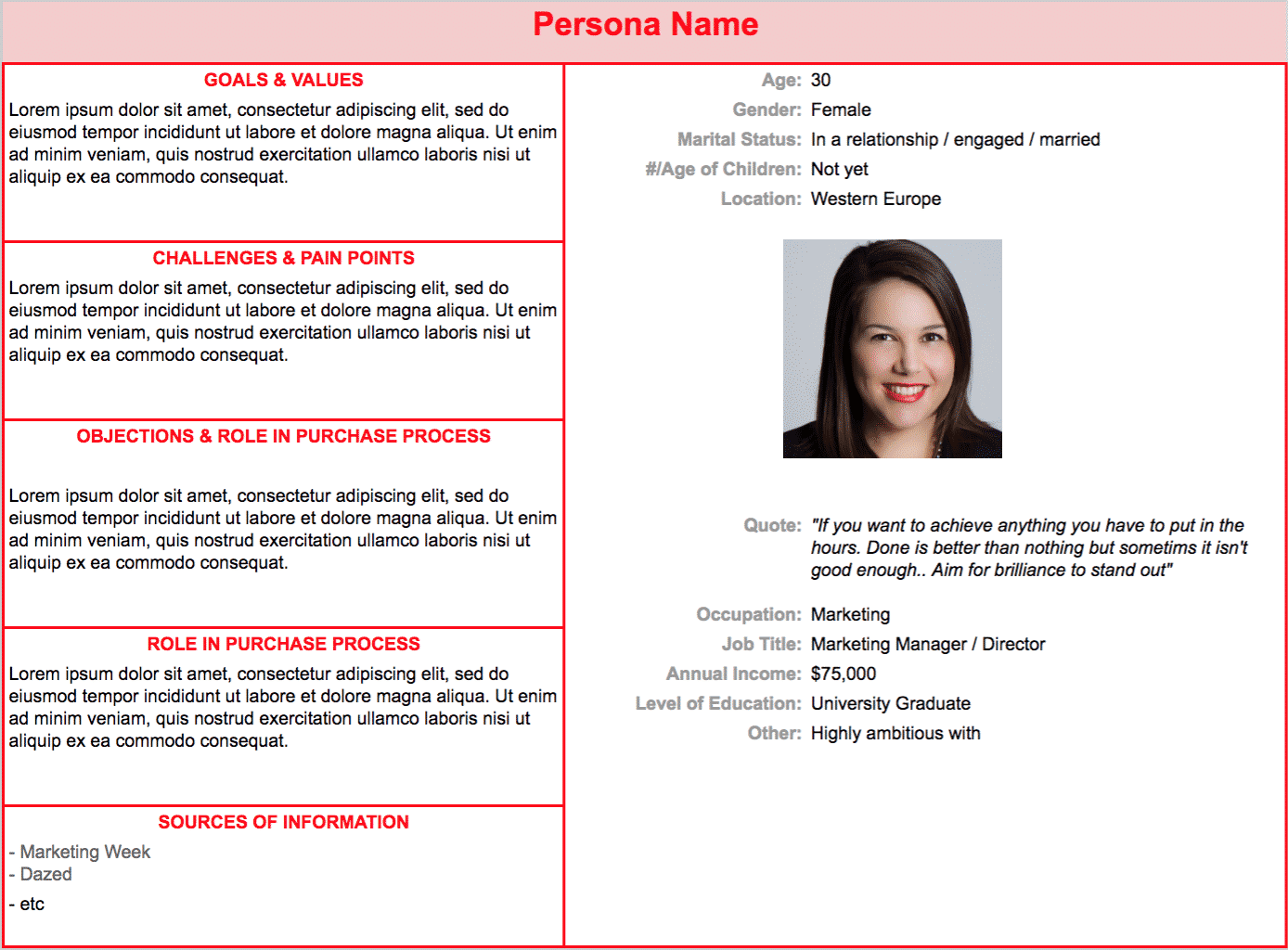
Here’s the persona / benefit grid:
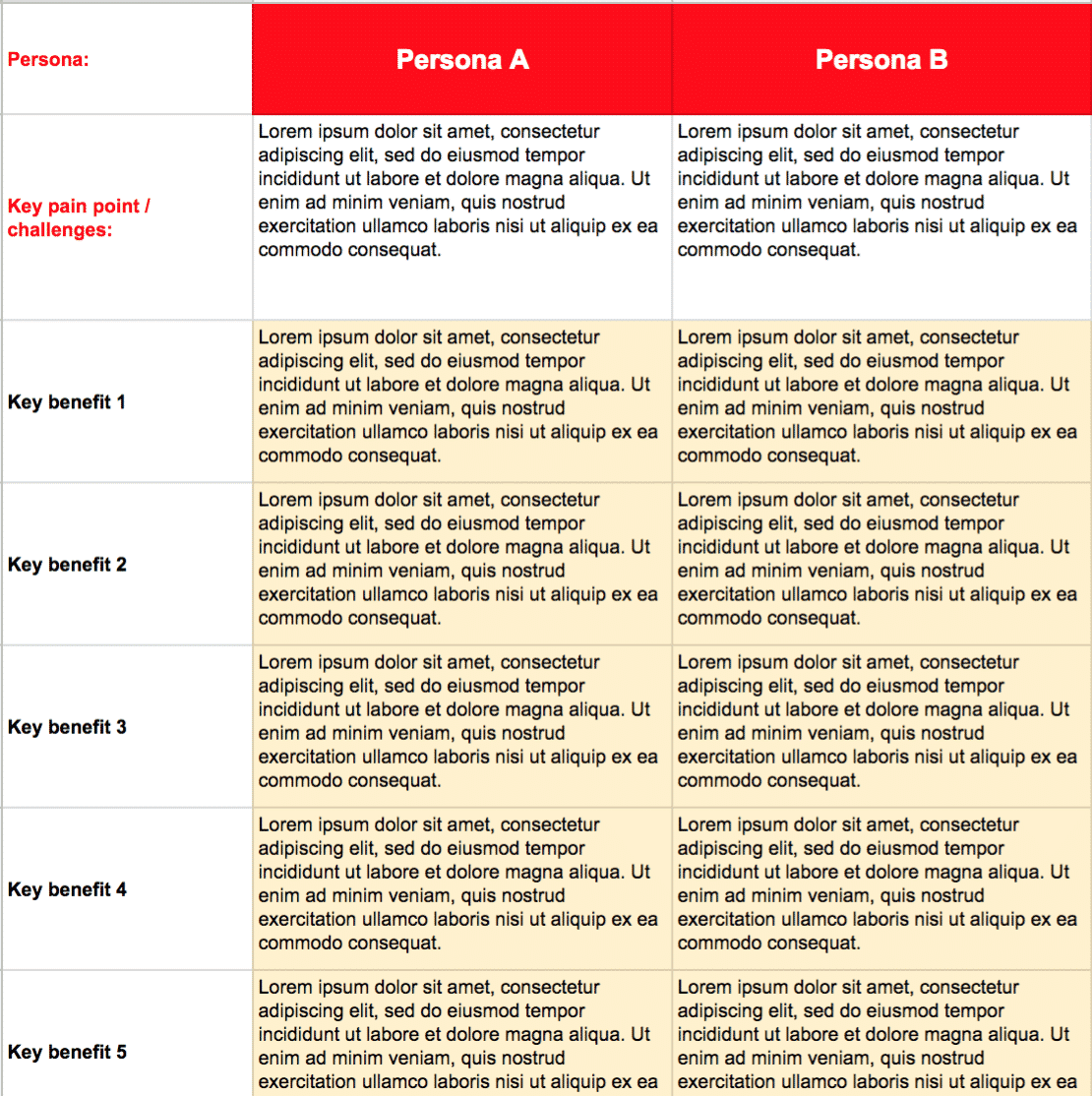 Trust me, this is a very useful exercise! This can make the difference between delivering a mediocre or outstanding content campaign. It impacts targeting, creatives, and sequences. The above persona / benefit grid can also be applied to ensure consistency in marketing message across various channels, from paid search to social to content marketing and automation. It’s worth taking the time to get this right, and feedback from relevant stakeholders will benefit your work.
Trust me, this is a very useful exercise! This can make the difference between delivering a mediocre or outstanding content campaign. It impacts targeting, creatives, and sequences. The above persona / benefit grid can also be applied to ensure consistency in marketing message across various channels, from paid search to social to content marketing and automation. It’s worth taking the time to get this right, and feedback from relevant stakeholders will benefit your work.
Optimising the Buyer's Journey for Marketing Automation
Consider this: what do your customers need to experience to progress from awareness (cold) through to decision and purchase (hot)? This is your buyer journey. It will vary if you have multiple personas. Automation allows you to personalise content at scale, but it also allows you to serve the perfect content to your audience based on their position in this journey. Automation should serve content which helps them make smooth progress on the road to purchase.
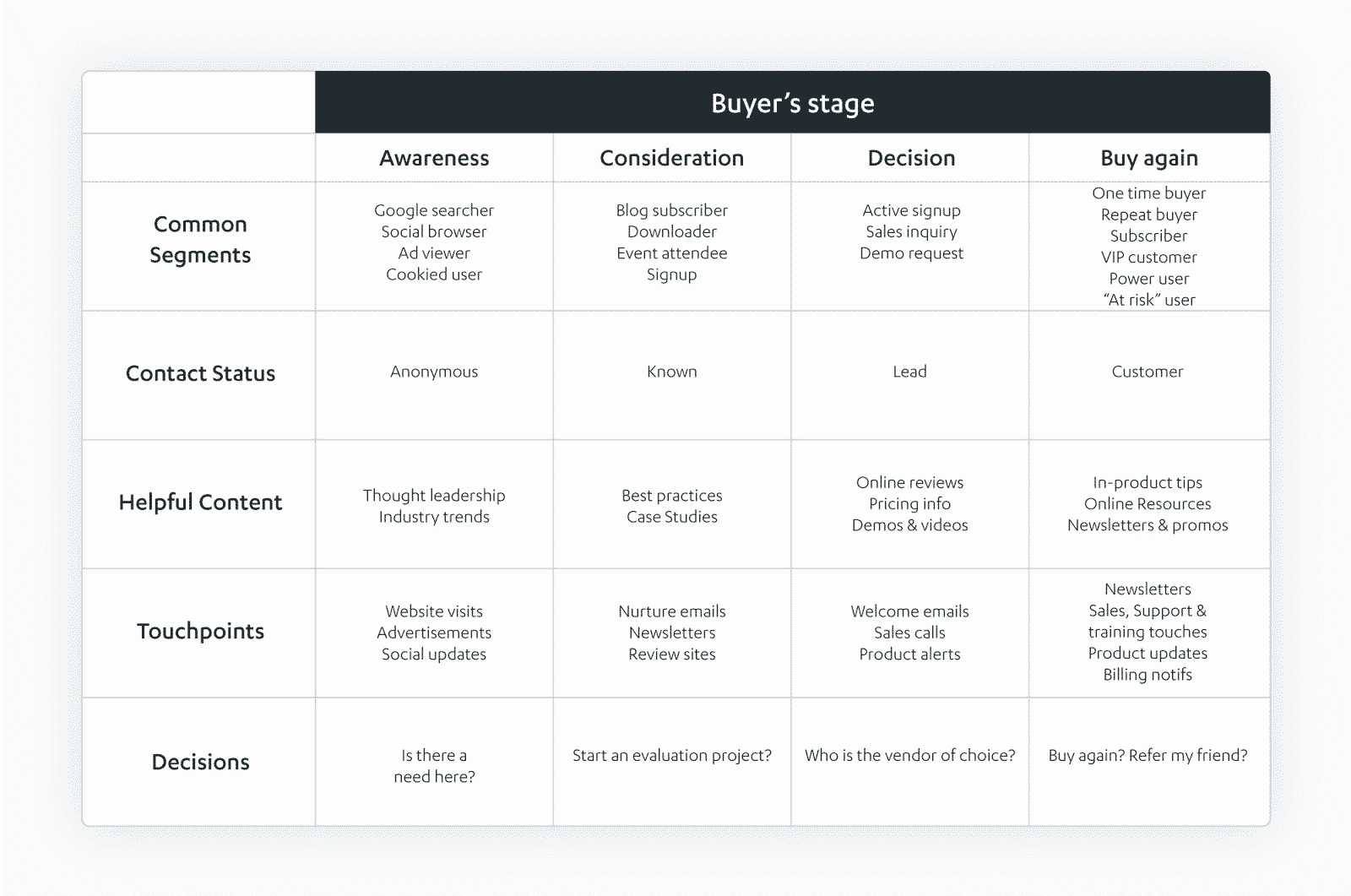 Source: Autopilot Flightschool
Source: Autopilot Flightschool
Take time to work through the buyer journey for each persona, and for your different revenue streams. Also read: What’s the Secret to a Perfect Customer Journey Map?
Content Audit: Spotting the Gaps for Marketing Automation Sequences
Once the above is taken care of, it’s time to evaluate the content at your disposal. Now you can spot the gaps, and plan how to fill them. If you’re embarking on a lead nurture sequence with automation, you need to serve content to help the prospect progress along the buyer journey. This means that you need different types of content, each of which must be pertinent to a particular stage. You might already have most of what you need, so the first task is to determine this with an audit. List every piece of content that has been created and categorise by the relevant persona and which stage of the journey it matches. This will highlight the gaps, meaning you can take immediate steps to create new content whilst establishing your marketing automation project.
6. Clean Data for Marketing Automation: GIGO (Garbage in, Garbage out)

Automation doesn’t “make mistakes” by itself. It is the setup or the data that is wrong in these instances.
Tidy the Data Before Firing up Marketing Automation
Prior to import or synchronisation with an automation tool, the data must be tidied up. For example, a sales team have records that need to sync with software. This needs some time with data hygiene, consisting of updating missing fields, capitalising names, deleting bad records, and setting the opportunity stage – and more. Why is this so important? Automation journeys may be triggered based on what’s in the CRM system. The following scenarios are entirely possible, and it would be the fault of the sales team for not looking after data hygiene sufficiently:
Marketing Automation Bad Data Scenario 1:
A loyal and top-paying customer named Mary Jones gets an email addressed “Dear mjones…” asking her to subscribe to a free trial. Mary is not impressed. What went wrong? The name is spelt wrong, and the lead wasn’t marked as closed and won in the CRM and so it was accidentally included in a cold lead nurture sequence.
Marketing Automation Bad Data Scenario 2:
A disgruntled hard-to-impress customer with an ongoing support ticket gets an automated email which asks them for a review. Naturally, this increases the likelihood of receiving bad reviews. What went wrong? There should be a system in place to flag customers and remove them from automation sequences.
List Management & Journey Management
List organisation needs consideration and planning. This is a fluid operation whereby contacts will need to be added to, and removed from, different lists as they progress through the automated buyer journey. It’s surprising how quickly lists, segments, and automation journeys grow. The system expands fast, and this can get chaotic if you haven’t planned from the outset. For example, it’s wise to set up folders to contain lists for:
-
Lead nurture
-
Customer success
-
Churn
-
Imported lists
-
Miscellaneous

Naming Conventions for Marketing Automation
Naming conventions are critical. For example, all lead nurture (LN) journeys could start with LN1: “name” then LN2: “name”. Customer success could be CS1: “name”, and so on… In practice, you could have a list of journeys like the following:
-
LN1: Top Strategies eBook
-
LN2: Consulting White Paper
-
LN3: Facebook Marketing Email Course
-
OB1: First 2 weeks (OB stands for onboarding)
-
CS1…
When creating the huge number of emails required, you could use a naming convention such as: LN1:Email1: “Thanks for downloading the Top Strategies eBook” LN1:Email2: “Why you need marketing automation to grow your business” LN1:Email3:.. etc.
Setting up a Journey Planner
It’s remarkably helpful to set up a planning document to bring structure and organisation to your automation project. This should incorporate every sequence you build. Below you will see an example of the type of document I use, which is a tremendous help for keeping everything tidy: 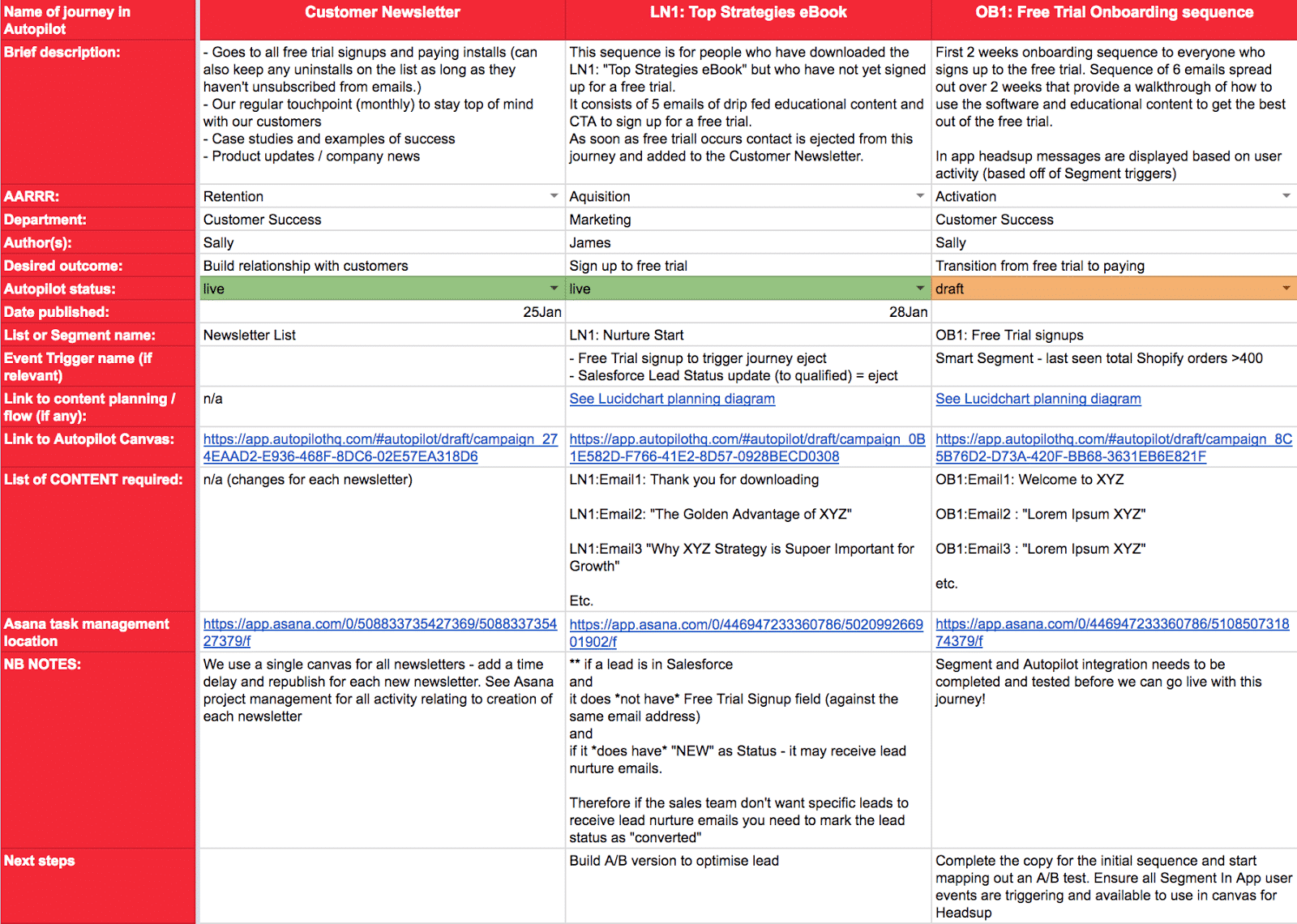
An example of a Journey Planner sheet
“The 360-degree customer view is the idea, sometimes considered unattainable, that companies can get a complete view of customers by aggregating data from the various touch points that a customer may use to contact a company to purchase products and receive service and support.” - Margaret Rouse, TechTarget
With the right integration and planning, automation can bring you a step closer to this elusive and mythical “360 view” of the customer across your marketing tech stack. For the most part, your automation software is designed to provide a view of your contacts / users / customers as they respond to marketing and sales activity, transitioning from an unknown website visitor to a subscribing customer (and beyond). Automation software’s purpose is to do this at scale, whilst reducing the margin for error. Depending on the software, this is usually accomplished by installing a script into the header of your website properties. Depending on your business model, this might also include the installation of a script into your product (e.g. in an app for a SaaS business). Through integration of tools such as the company database, product API, Google Tag Manager, Google Analytics, CRM, and Helpdesk, you can cement the single view yet further. During your planning, you’ll want to map out all your customer touch-points, and layer that understanding on top of your marketing tech stack. With regards to marketing automation implementation, the key question to ask is whether your choice in software is bringing you closer to a single view or not? Evaluate the pros and cons of each martech stack component in relation to the 360 view. A great tip is to find a senior solutions architect or technical support expert at your software vendor and build a relationship with them individually. This is something that we’ve done at Autopilot. These are some critical questions to consider:
-
Where is your “True North?” i.e. which system do you consider to be the repository of the most accurate and complete view of the customer? Is this your CRM, data warehouse, or the automation software itself? Typically a data warehouse would centralise your data flows
-
How do you feed data in “True North”, ensuring no duplication or overwriting of correct data?
-
What is the method for identifying contacts and relating each to a unique ID for each record?
-
Does this flow across tools and devices? Will you need to alias your user IDs?
-
Do you need a tool like Segment to help marry different components of your tech stack together?
Be Pragmatic When You Can't Achieve the Full View
Achieving a 360 view of the customer is worth striving for, and investment in this pursuit is worthwhile. However, I advise a pragmatic approach. Done is better than perfect. Sometimes 100% accuracy isn’t always possible or necessary, similarly to campaign attribution. Metrics should provide enough information to help you make better marketing and product decisions. These will ultimately help you to generate more revenue. Don’t get me wrong… data and metrics need to be as accurate as possible .
8. Prioritise the Top 3 Automation Journeys
It’s a common mistake to be too ambitious about the number, size, and scope of automation journeys with which to go live. There’s nothing wrong with ambition or setting high expectations of a project team, but my advice is to start with a solid foundation and grow from this base . An agile methodology is useful. For example, in the Autopilot planner document shown above, you might start with the basics like a customer newsletter plus one lead nurture (e.g. an eBook download), and one onboarding sequence. Getting these in place for initial sprints will ensure that you have everything you need to build bigger and better journeys in the future.

Note: If you’re using a consultant or agency to implement your automation, you should get the internal team involved in building the initial journeys. These are the people who will manage the software and processes in the future, so it’s critical for them to have a baseline understanding. In an ideal scenario, the internal team will build the content and shadow the creation of the sequences in the software. This is valuable for training.
9. Team Training & Marketing Technology Onboarding
Talking about training, it’s important to document processes for those who follow. There’s nothing new here; this applies to almost any project as you need to capture processes and mitigate risk when employees move on. “The Automator” should be responsible for getting this together, including:
-
A “Wiki” or repository (Confluence, Google Drive, or similar) for all relevant documents
-
An onboarding checklist (like this one provided to us by Autopilot)
-
A system (journey planner) to be followed each time a new sequence is planned
-
QA process or checklist for new automation journeys (like this one)
-
A handover session for the internal team and stakeholders
10. Reporting & Goals
Once a tool is in place, its insights must be shared beyond the marketing department. Fortunately, most marketing automation tools have the ability to report on campaigns. When planning out each automation sequence, take a moment to consider the desired outcome, and how you plan to report on on whether or not that outcome is reached. As an example, in Autopilot you can set a “goal” for each automation sequence. This enables you to:
-
Measure the performance of a journey against a goal
-
View the average number of days and touches it takes to achieve a conversion
-
Compare how each message in the journey is performing

Once set up, it’s easy to run reports on journeys.

Note: You can read more about Autopilot Reports here, and there’s more information about Autopilot Insights here. Other tools have similar features.
Summary: Strategy for Marketing Automation Implementation
Successful marketing automation implementation has a flexible formula. The steps outlined in this article will give you a base from which to work, and guidance for where to focus. Of course, each technology has its own nuances, but the principles of preparation don’t change. Above all, marketing automation must be implemented with a considered approach, carefully documented and organised with a long-term perspective in mind. An automation project is also the ideal time to revisit data health, audience targeting, and buyer journey - elements that might otherwise be left alone for too long. In order for automation to scale your growth and enhance your return on investment, the setup must be right. I hope this guide has contributed to your understanding of what it takes to achieve this.
I’m always looking to grow my network with fellow marketing automation experts. You can connect with me on LinkedIn here . We’ve also set up a Slack group for UK and EU Autopilot users. If you’re interested in joining for knowledge share and top tips, ping me a message and I will invite you.
